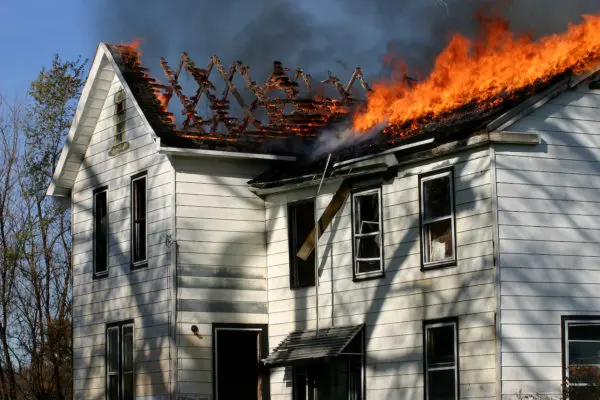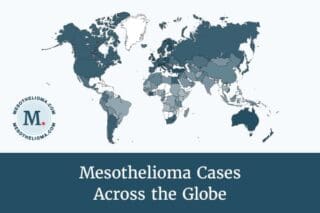
Asbestos is a mineral frequently used in home construction products before the 1980s. However, asbestos exposure can cause mesothelioma cancer and other illnesses. The mineral may be released in the wake of disasters, including fires.
Unfortunately, house fires are more likely to occur during the holiday season. These fires can disturb asbestos-containing materials around the home and release asbestos dust. Homeowners and residents should protect themselves against asbestos exposure if one of these disasters occurs.
How Does Asbestos Exposure Occur During House Fires?
Asbestos was used in construction materials for its durability and resistance to chemicals and heat. During a fire, asbestos-containing materials may be exposed, disturbed or destroyed. Airborne asbestos fibers can pose a health risk to anyone in the vicinity. If inhaled or ingested, asbestos can cause asbestosis, lung cancer and mesothelioma.
Common asbestos-containing construction products include:
- Asbestos cement
- Asbestos felt
- Asbestos insulation
- Asbestos paper
- Asbestos sheets
- Boilers
- Ceiling, floor and wall tiles
- Ductwork
- Electrical work
- Fireproofing products
- Flooring
- Furnaces
- Gaskets
- Generators
- HVAC systems
- Pipes and plumbing
- Plaster
- Popcorn ceilings
- Roofing
- Sheetrock
- Shingles
- Siding
- Valves
- Vinyl
- Wiring
Damage to any of these asbestos products can release fibers. Fires can be particularly dangerous because they may expose hidden or encapsulated asbestos.
According to the American Red Cross, nearly 47,000 fires occur annually during the winter holidays. These fires cause injuries, claim lives, cost millions in property damage and can contribute to asbestos exposure.
Asbestos exposure of any level can lead to serious health consequences. As a result, protection against contact with the mineral is important. The mineral can be found in thousands of older buildings, including homes.
Environmental Protection Agency (EPA) regulations introduced in the late 1970s and early 1980s heavily curbed asbestos use. Homes built after the 1980s are less likely to contain the mineral. But, older homes and building products may still harbor asbestos-containing materials that could pose serious risks if damaged by fire.
How Do Holiday Home Fires Begin?
The hustle and bustle of the holiday season may lead to unexpected consequences. The American Red Cross (ARC) cites Christmas trees, lit candles and children playing as potential causes of home fires during the winter holidays. Cooking fires are also a big concern during this time of year, according to the National Fire Protection Association (NFPA).
NFPA data also reveals Christmas tree fires alone account for about 160 fires annually. Electrical or lighting equipment was involved in 45% of home Christmas tree fires, while 22% of tree fires were caused by proximity to a heat source.
Many of these fires may be preventable with increased vigilance and attention to faulty equipment. Preventing indoor fires can help save lives, money and stress during holiday seasons.
How Can I Protect My Family From Asbestos Exposure?
Even with asbestos regulations to curb the mineral’s use, many individuals may still face exposure. In the case of a house fire, there are two main ways to protect against asbestos diseases:
- Addressing any asbestos issues in the house
- Following fire safety guidance
These methods for avoiding asbestos exposure will help protect against asbestos-related diseases.
Address Home Asbestos Concerns
If your home has asbestos, you can hire an asbestos remediation company to remove the offending materials. Asbestos handling should only be performed by certified professionals. Certification programs and procedures often vary by state.
If you are not sure of your home’s asbestos status, contact a remediation company to assess potential threats and create a mitigation plan.
If a fire occurs while your home still contains asbestos, be sure to wear personal protective equipment (PPE) and protect your airways. Make sure any personnel involved in the rebuilding process adhere to asbestos procedures in your area.
Follow Fire Preparedness Guidelines
The American Red Cross has published safety and preparedness tips to avoid home fires this season. These instructions can help families steer clear of costly fires and related health issues.
- Place Christmas trees, candles and other holiday decorations at least three feet away from heat sources. Potentially hazardous heat sources include fireplaces, portable heaters, radiators, heat vents and candles.
- Keep live Christmas trees as moist as possible with plenty of water.
- Make sure that light strings and other electrical holiday decorations are in good condition. Do not use anything with frayed electrical cords and always follow the manufacturer’s instructions.
- Always unplug trees and holiday lights before leaving home or going to bed. Always extinguish candles before leaving the room or going to bed.
- Avoid falling Christmas trees with sturdy tree stands designed not to tip over. Keep curious pets and children away from Christmas trees.
- Keep anything that can catch on fire away from your stovetop. This includes potholders, oven mitts, wooden utensils, paper or plastic bags, food packaging, towels or curtains.
- Designate someone to walk through the home after guests leave to ensure all candles and smoking materials are properly extinguished.
- Keep smoke alarms installed, placed near potential fire hazards and refreshed with new batteries.
There are many stressors following a house fire. Being aware of asbestos and taking the appropriate measures to protect yourself and loved ones can help prevent further stress over asbestos exposure.




